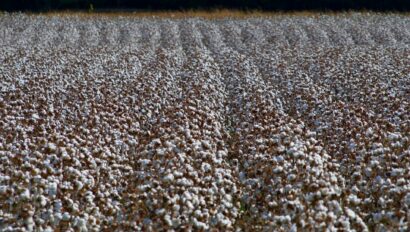Textile Exchange Organic Cotton Update
Download Organic Cotton Update
At Textile Exchange, we’re committed to driving positive impact on climate change. The goal of our Climate+ strategy is to help the global fashion and textile industry achieve a 45% reduction in the emissions that come from producing fibers and raw materials by 2030, in line with what is needed to limit global warming to 1.5°C.
We believe that organic agriculture will play a key role in helping the industry reach this target. That’s why we’re sharing our perspective on an investigation published in the New York Times on February 13, 2022, into organic cotton certification in India.
Organic cotton is a complex, multi-layered subject, and one that can quickly lose critical nuance when condensed into a single article. Without the right context, the piece risks undermining the importance of organic agriculture, while skipping over the solutions.
With long-term investment from the marketplace, organic cotton can bring immense benefits to the fashion and textile industry, and our planet too. This way of farming favours place-based practices over external inputs, helping to safeguard the health of people and the land. And ultimately, when we commit to understanding where our cotton comes from and building long-term relationships with those who grow it, the whole system starts to shift.
Breaking down the challenges faced by farmers, as well as the complexities of the organic cotton certification system, requires ongoing dialogue with stakeholders from all stages of the supply chain. This must come from a shared understanding of what organic cotton can offer and how certification systems work.
That is why we are taking the opportunity to dig deeper into this topic, providing a common context for all those working in this area, in addition to some of the key actions needed to improve the integrity of the industry, and the solutions that Textile Exchange is already working on.
What is organic cotton?
Organic cotton is cotton grown in agricultural systems that work with nature, rather than against it. The organic way of farming combines tradition, innovation, and science to benefit the environment, promoting fair relationships and improved quality of life for all.
Organic farming systems have the potential to sustain and promote the health of soils, ecosystems, and people by relying on ecological processes, biodiversity, and cycles that are adapted to local conditions rather than using external inputs that could have adverse effects.
Let’s look at an example. Rather than using synthetic nitrogen fertilizer, which results in the release of large quantities of greenhouse gases from both its production and in-field use, organic farmers establish management systems that might involve crop rotation and green manures instead. In this way, they naturally build soil health.
Organic cotton holds huge amounts of promise on a multitude of levels, and the opportunity we have before us now is to ensure that what is grown organically is what makes it to the finished product.
What are organic standards and why do we have them?
Unlike terms such as “natural” or “sustainable,” the core principles of organic farming have been enshrined in law. This ensures all farmers who want to sell what they grow as organic must meet a common baseline.
Many organic farmers go above and beyond this baseline. But, at the very least, every farmer selling their crops as organic must meet a set of strict rules that include requirements around soil health and the prohibition of artificial fertilizers, hazardous synthetic pesticides, and genetically modified organisms (GMOs).
Once the cotton leaves the farm, it isn’t automatically covered by the same legal protections. However, private standard-setting organizations have developed voluntary standards that bridge the gap to finished product.
The most common of these finished product standards are Textile Exchange’s Organic Content Standard (OCS) and the Global Organic Textile Standard (GOTS). Both these standards accept organic cotton inputs from farms certified to organic standards recognized by the International Federation of Organic Agriculture Movements (IFOAM). These include the regulations in the primary cotton-producing countries such as India.
Independent third-party certification plays an important role in verifying the status of organic cotton. Becoming certified to the OCS or GOTS means subscribing to a system of monitoring and certification that helps connect the dots throughout the supply network.
How does organic certification work?
There are two types of certifications for organic cotton: farm-level certification and finished product certification.
Farm-level certification
Third-party certification bodies verify that organic farmers meet strict national organic laws and regulations. Organic farmers must keep records to show that they are meeting full organic standards 365 days of the year, and their farms are also inspected in person at least once a year.
It’s a big commitment for a farmer as certification also adds additional costs for them, including paying a fee to become certified.
Finished product certification
Finished product certifications like Textile Exchange’s Organic Content Standard (OCS) are designed to ensure organic standards are respected as the fibers make their way along the supply chain. While OCS is not a farm-level standard, we remain close to what is happening on the ground through our ambassadors and members working directly with organic farms.
There are three key parties that play a key role in our assurance process:
The standard-setting body: As a standard-setting body, Textile Exchange creates standards for the segregation, identification, and volume reconciliation of organically grown content at each stage of the supply chain. Our standards are then enforced by certification bodies.
Certification bodies: Third-party certification bodies verify our requirements through annual audits, as well as volume monitoring throughout the year. Each time goods like yarns or fabrics are sold, the certification body issues transaction certificates based on volume. This chain of custody requires everyone along the supply chain to do their part to ensure the standard of the certified material is maintained.
Accreditation bodies: Accreditation bodies monitor and assess the certification bodies to ensure that they are operating as intended. This assurance process allows us to detect irregularities, in turn protecting the intrinsic value of the fiber and delivering confidence to consumers.
If inconsistencies in volume arise, we work directly with the certification bodies and accreditation bodies to resolve them. If the issue lies with the supplier, it’s up to our certification bodies to grant or withdraw certification or transaction certificates, and the full Textile Exchange banned list is available here. In the instance of wider irregularities, we as the standard-setting body reserve the right to terminate our licensing contract with the certification body involved, which happened as recently as 2020.
What can brands do to protect integrity in the organic cotton sector?
Everyone along the organic cotton supply chain has a role to play in protecting the integrity of the industry and ensuring that certification programs are working as intended. With organic cotton in high demand, it’s more important than ever to strengthen the system.
Increasing the supply of organic cotton available can help to reduce pressure on the market. This can be done by sourcing and supporting more “in-conversion” cotton, which comes from farmers that are in the two-to-three-year process of transitioning their land to organic. You can find out more about in-conversion cotton and how to support it here.
Understanding where your cotton comes from and improving how the risks and rewards of transitioning to organic farming are shared across the system are some of the best things that brands can do. This can be done by investing in long-term relationships with farmers and facilitating education and training.
What is Textile Exchange doing to improve traceability in the organic cotton sector?
Textile Exchange is committed to increasing the transparency of preferred material supply chains and data is our most powerful ally to make this happen.
By crunching the numbers on the volumes of preferred materials produced every year through our Material Change Index, we can understand more about whether these materials are growing in their share, helping us make them the accessible default. Meanwhile, collecting data on the transactions of preferred materials bought and sold throughout the supply chain allows us to pinpoint with greater accuracy when and where there are mistakes or inconsistencies and address their route cause. This type of information can also help participating companies better understand what is happening in their supply chain.
We’re also using data and technology together with refining our standards to ensure our chain of custody is continually improving. We are doing this by moving away from a disaggregated to a centralized approach to managing our certification data and exploring ways that new technologies such as physical tracers or isotope testing can be used to further strengthen chain of custody verification. These systems make the tracing of certified materials easier for brands and build integrity into the supply chain. We have even helped implement a global testing protocol to detect the presence of genetically modified organisms in organic cotton.
When it comes to our standards, we are revising the whole suite. Our aim is to incorporate requirements around monitoring and evaluation of impact in relation to key issues such as climate change, biodiversity, and soil health, and water availability and quality.
Finally, our Organic Cotton Round Table (OCRT) convenes the global organic cotton community to collaboratively facilitate the journey to organic, educate brands about organic cotton, build transparency, and create an environment for the organic sector to thrive.
Join us in working to make the organic system the best it can be, together.
About Textile Exchange
Textile Exchange is a global non-profit driving positive impact on climate change across the fashion and textile industry. It guides a growing community of brands, manufacturers, and farmers towards more purposeful production from the very start of the supply chain.
Its goal is to help the industry to achieve a 45% reduction in the emissions that come from producing fibers and raw materials by 2030. To get there, it is keeping its focus holistic and interconnected, accelerating the adoption of practices that improve the state of our water, soil health, and biodiversity too.
For real change to happen, everyone needs a clear path to positive impact. That’s why Textile Exchange believes that approachable, step-by-step instruction paired with collective action can change the system to make preferred materials and fibers an accessible default, mobilizing leaders through attainable strategies, proven solutions and a driven community.
At Textile Exchange, materials matter. To learn more, visit textileexchange.org.
Media Contact: communications@textileexchange.org.


